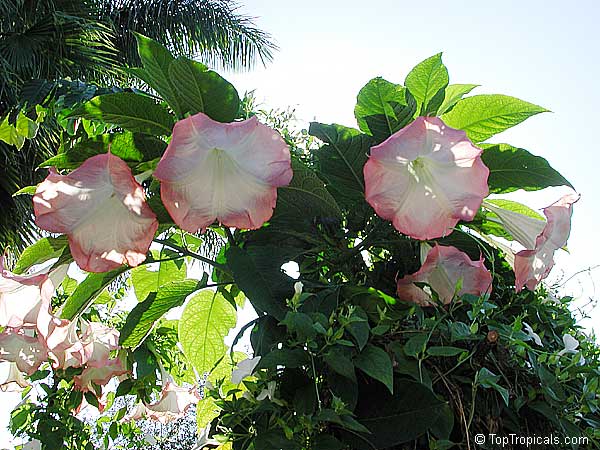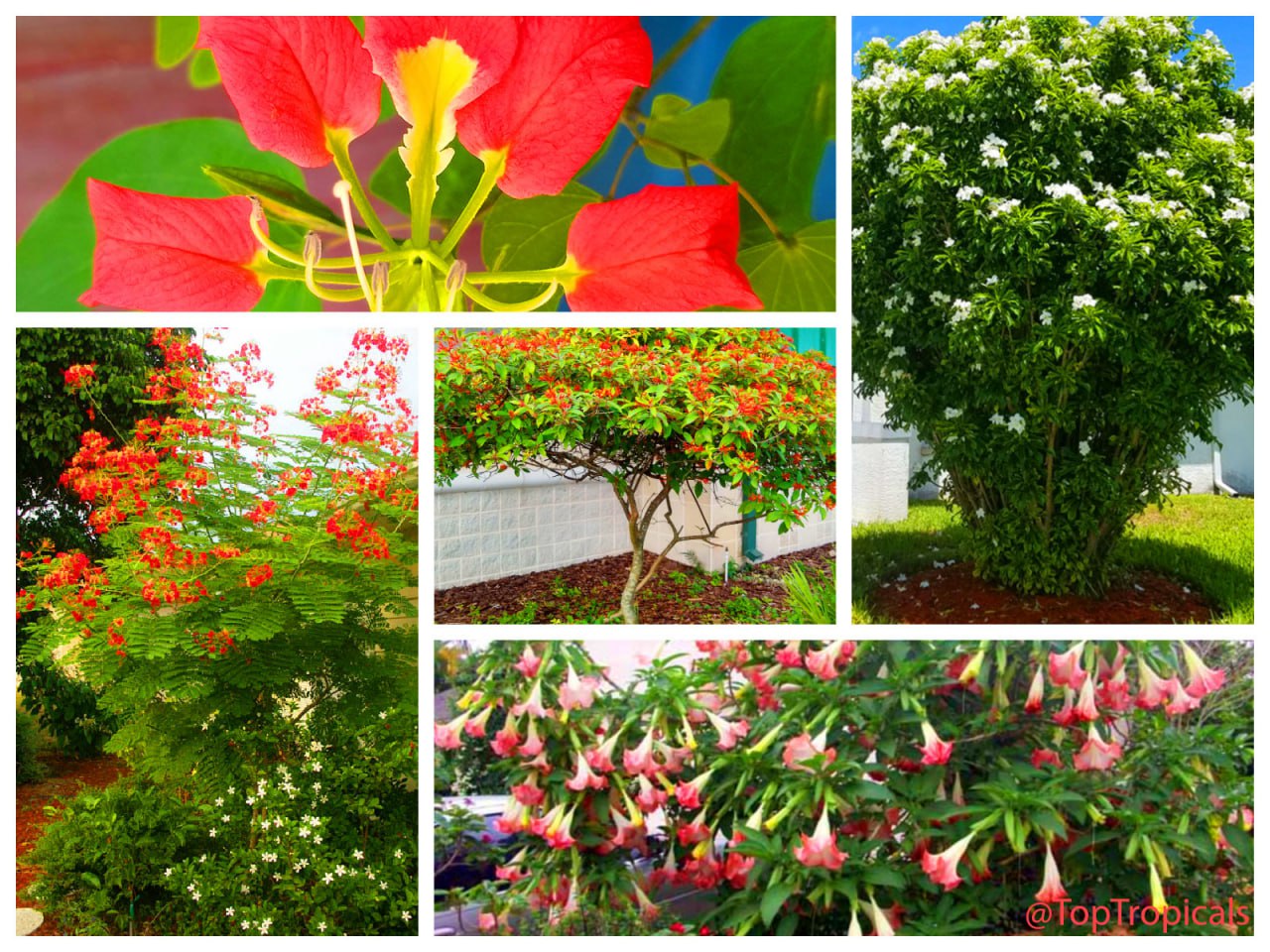Garden Blog - Top Tropicals
Flower of Angels that every gardener wants: Angels Trumpet
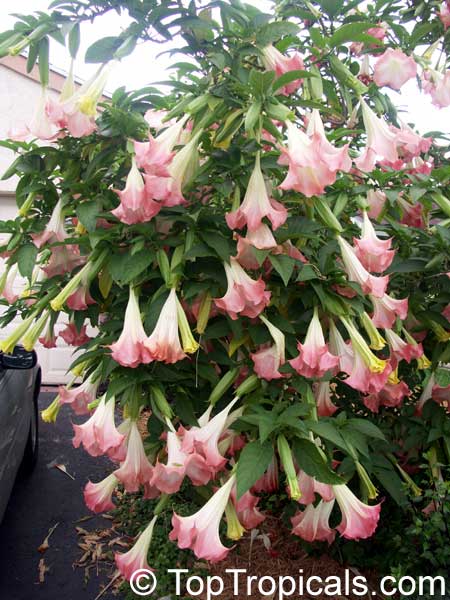
Angel's Trumpet (Brugmansia) pink
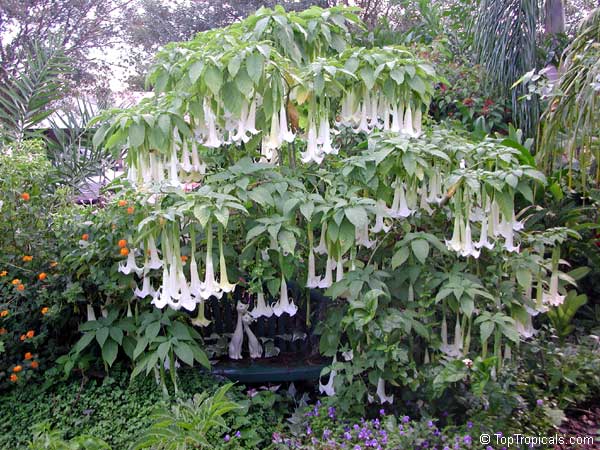
Angel's Trumpet (Brugmansia) white
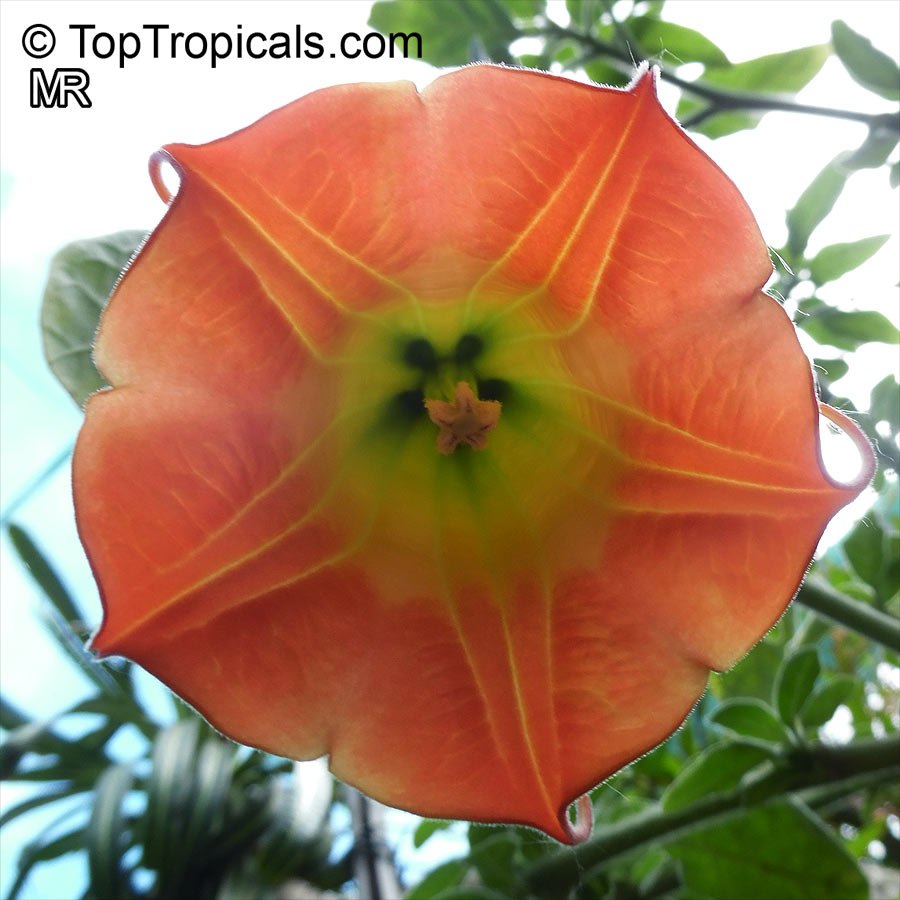
Angel's Trumpet (Brugmansia) peach

Angel's Trumpet (Brugmansia) yellow
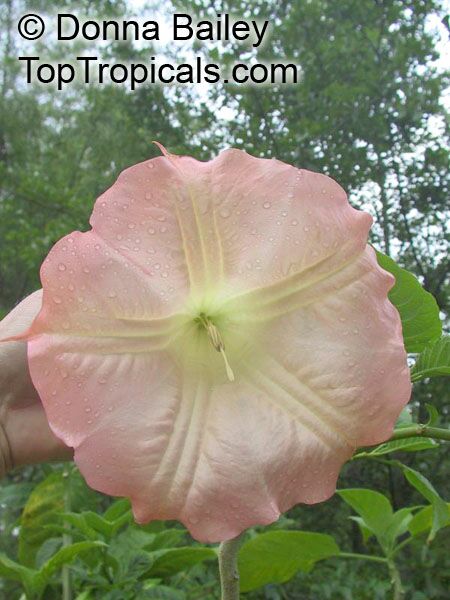
Angel's Trumpet (Brugmansia) pink
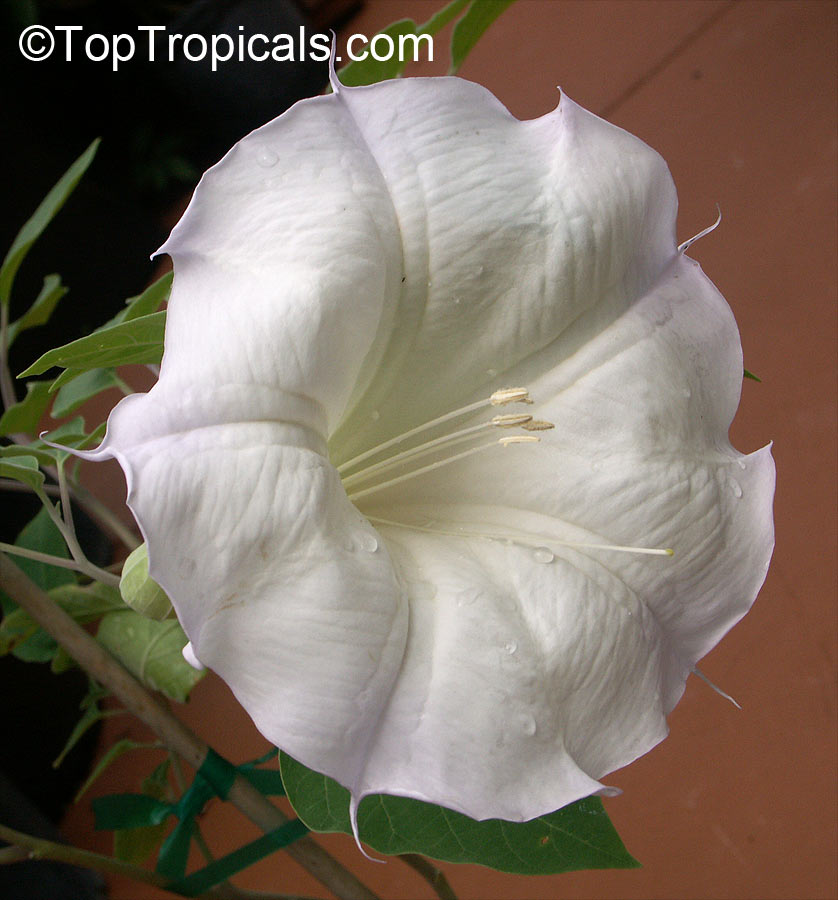
Angel's Trumpet (Brugmansia) white
- 🎺 Angel's Trumpet (Brugmansia) is one of the most wanted flowering shrubs in Southern landscapes.
- 🎺 It is known for its large, trumpet-shaped flowers that hang downward from the branches.
- 🎺 The flowers come in a range of colors🌈 including white, yellow, pink, orange, and emit a sweet, intoxicating fragrance, especially in the evening.
- 🎺 Very easy to grow and undemanding, this fast growing shrub or a small tree will fill your garden with happiness, blooms and fragrance just within one season.
- 🎺 Heavy feeder! Apply fertilizer on a monthly basis for rapid growth and free flowering.
🛒 Shop Angel's Trumpets
#Perfume_Plants #Hedges_with_benefits
🏵 TopTropicals
Date:
TROPICAL GARDENING: How to grow Brugmansia (Angel Trumpet) in the ground outside.
Q: I recently moved from New Jersey to Florida and I brought with me my Brugmansia that I used to have as a house plant. Can I plant it in the ground now?
A: Angel Trumpet - Brugmansia - is a very popular container plant
valued for its large, stunning fragrant flowers. Originated from South
America, it will be happy to grow in tropical to subtropical climate outdoors.
These are a few useful tips to get the most out of this beautiful plant:
1) Light. Plant it in full sun - the more sun, the more flowers
you get, although Brugmansias tolerate shade. If the plant was previously
grown in container indoors, to avoid leaf burn, keep it protected with a shade
cloth or simply white sheet for a while and gradually open to adjust to full
sun.
2) Soil and fertilizer. Use fertile soil with lots of organic
matter (add compost to existing soil). It must be very well drained, Angel
Trumpet won't tolerate waterlogged conditions. Plant it on a little "hill"
elevated 3-4" above the surrounding area. Brugmansias are very heavy feeders. Once
the plant is established, fertilize on regular basis with Slow Release Fertilizer - a handful once a
month.
3) Water. Water daily until established. Once the root system is
well developed, the plant is drought tolerant and won't require too much
care. But at the beginning, watch the leaves - the lush foliage droops quickly
if the plant is thirsty.
4) Plan space. Brugmansia is a short tree, but it needs a lot of
room to spread branches with its heavy hanging flowers. Think 12" wide and
maybe almost as much tall.
5) Support. Being widespread plant, Brugmansia can be blown with
strong winds. Stake with strong support until established.
6) Propagation. Brugmansia is one of the few plants that
propagates with semi-woody cuttings; soft green cuttings usually have little
success. Other than that, it is pretty easy!
Check out our Brugmansia collection and... collect them all!
Date:
Heavenly Angel's Trumpet
By Onika Amell, tropical flower specialist
Q: Can you please tell me which zones are the best for growing Angel Trumpets? When do they bloom and is there a specific fertilizer to use on them? Do you sell any variegated varieties?
A: If you are lucky enough to live in an area that doesn't freeze or only has light frosts, you can grow Brugmansia (common name Angel Trumpet) outside all year long. They are only entirely hardy in USDA zones 9-12, but they remain very popular throughout the United States. They do really well in coastal settings in the Southwest. They are simply glorious in the coastal areas of South California. In the southwestern states, as well as in the tropics, they bloom spectacularly throughout the spring, summer, and autumn.
Angel Trumpets are very heavy feeders and they need huge amounts of nitrogen. You can use a standard balanced slow-release fertilizer on Brugmansia, but then you must apply it very generously. We've created a specialized fertilizer just for them. Angel Trumpet Delight is a perfect Brugmansia food for frequent monthly feed. It's a 30-day Smart-Release formula that works wonders for Angel Trumpets. A a well-balanced combination of macro- and micro- nutrients with a slow release action, it provides continuous feed, maintains vigor and disease resistance. It also contains coated nitrogen, early release nutrients and extra iron (water soluble and chelated) for quick green-up.
Angel Trumpets come in a dazzling array of colors: orange, yellow, green, white, pink, red, emerald and even purple (closely related Datura). One of our favorites is the beautiful Variegated Orange Angel Trumpet, a new hybrid with variegated leaves and a large single bloom that starts white and turns orange. Another amazing variety is "Sun Explosion" - with a variegated orange flower.
Most folks are usually in awe of the enormous trumpet flowers when they see it for the very first time. They most definitely need to be planted where they can be admired… near a deck, terrace, lanai or, entryway. The blossoms are short-lived, but numerous, continuous, and truly show-stopping! And they smell so good! This is a must have in any tropical garden. They can be grown either as a bush or a small tree. They are easy peasy to grow and root extremely easily, making them great as pass-along gifts for friends. They are sun-loving and super fast-growing plants. Plenty of water and fertilizers keep them happy and at their best. Did I mention they smell good too? ;)
Date:
How to grow Angel Trumpet in Florida
Q: I purchased an Angel trumpet in March, 2018. It wasn't looking very good so I asked what to do about it. Your reply was to fertilize and keep it watered. I did & it started to improve. I went on vacation & it reverted, dropping leaves... How do I keep it happy?
A: With growing Angel Trumpets in Florida, there are a few things that may go wrong, although in general Brugmansia is a vigorous rapid grower. Once the plant is established, it is very easy to grow. Looks like your plant had some troubles at the start and is still struggling. Dropping leaves could be a sign of a root problem.
These are the main important points for Brugmansia growing:
1. Must be planted in a high spot, using very well-drained soil.
Brugmansias do not like soggy conditions (happens with Florida summer). They like
water, but only as long as drainage is good.
2. Full sun is a must for a healthy plant.
3. Brugmansias are heavy feeders. Fertilize at least once a month once
the plant is established:
Pink N Good Daily Plant Food - Flower Booster
Angel Trumpet Delight - Smart-Release Booster
4. They are susceptible to bugs... check underneath the leaves and if
any pests, spray with solution of any vegetable oil, water, and some dish
soap.
The bottom line is, do not overwater but don't let it dry out. It's
rainy season now, maybe too much rain affecting the plant.
Try these Sunshine Boosters, they have amazing results and often help
us to bring stressed and weak plants back to life:
SUNSHINE-Power - plant booster
SUNSHINE-E - plant booster
When Angel Trumpet is in bloom
Brugmansia suaveolens - Angel Trumpet
🌈 Brugmansia suaveolens - Angel Trumpet - one of the most popular favorites for Southern gardens. Small tree or bush with trumpet-like fragrant flowers that change color from white (bud) through yellow to pink (mature). Fast growing and easy to grow.
🛒 Shop Angel Trumpets
#Hedges_with_benefits #Trees #Perfume_Plants
🔴 Join 👉 TopTropicals
5 small tropical trees that bloom all summer or year around
Bauhinia madagascariensis, Brugmansia, Caesalpinia, Hamelia, Plumeria pudica
- 🌳 1. Bauhinia madagascariensis - Red Butterfly Orchid Tree. A rare small tree with scarlet blooms patterned like butterflies, highlighted with golden stripes at the petal bases. It grows fast, adapts to containers, and brings vivid color all summer.
- 🌳 2. Brugmansia - Angel Trumpet - Large, pendulous trumpet flowers make Brugmansia unforgettable, especially when they release their sweet fragrance at night. It flowers in cycles all summer, perfect for moon gardens and patios.
- 🌳 3. Caesalpinia - Pride of Barbados, Dwarf Poinciana, Bird of Paradise. This small tree explodes with bright red, orange, or yellow blooms all summer, like fireworks in the garden. It's drought-tolerant, fast-growing, and makes a bold focal point.
- 🌳 4. Hamelia - Fire Bush - is a pollinator favorite, covered in clusters of fiery orange-red blooms from spring through fall. Compact and easy to trim, it thrives in poor soil while attracting hummingbirds and butterflies.
- 🌳 5. Plumeria pudica - Bridal Bouquet
Unlike most plumerias, Bridal Bouquet keeps blooming all summer without resting. Its pure white flowers, neat form, and adaptability to pots make it an excellent patio or garden tree.
🛒 Check out tropical flowering trees
#Trees #Discover
🟢 Join 👉 TopTropicals
Date:
The Enchanting Datura
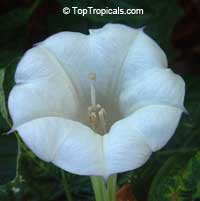
New article by
Jane Jordan
"...Commonly known as the Devils trumpet, Datura has long
been associated with witchcraft and voodoo rituals.
Ideally suited for moon or night gardens, the blooms are
fragrant and particularly so at night..." Continue reading...
5 important
tips for successful growing Datura and
Brugmansia;
1. Full sun
2. Use fertile soil that must be vewry well-drained. Plant
in elevation
3. Ample water encourages fast growth, but never allow wet
feet!
4. Fertilize heavily during hot season
5. Propagate Brugmansia with semi-woody cuttings, Datura -
with seeds that have a long shelf live
Buy Datura and Brugmansia from our store
Five small tropical trees that bloom for you all summer
📸 Pictures for the previous post:
- ▫️Bauhinia madagascariensis - Red Butterfly Orchid Tree
- ▫️Brugmansia - Angel Trumpet
- ▫️Caesalpinia - Pride of Barbados, Dwarf Poinciana, Bird of Paradise
- ▫️Hamelia - Fire Bush
- ▫️Plumeria pudica - Bridal Bouquet
🛒 Check out tropical flowering trees
#Trees #Discover
🟢 Join 👉 TopTropicals
What small plant can bring both beauty and aroma in your garden
Datura metel - Horn-of-Plenty
- ⭕️ A true showstopper, Datura metel - also known as Horn-of-Plenty - is a close relative of Angel Trumpet bush, but much more compact plant.
- ⭕️ It boasts huge, double trumpet-shaped flowers that spiral outward like a horn, often in a unique mottled purple shade. These blooms are not only spectacular in appearance but also richly fragrant, filling the air from spring through fall.
- ⭕️ Growing to 2–3 feet in containers, this fast-growing plant blooms repeatedly in spring, summer, and fall, adding a bold, tropical flair to gardens and patios.
- ⭕️ Datura has a long history of medicinal uses.
- ⭕️ With its exotic flowers, intoxicating scent, and lush foliage, Datura metel brings a mystical, surreal beauty to your garden like no other.
📚 More about Angel Trumpets:
Flower of Angels
Angel Trumpet in bloom
🛒 Plant Datura or Angel Trumpet for fragrant atmosphere 👍
#Perfume_Plants #Discover #Hedges_with_benefits
🔴 Join 👉 TopTropicals
What flowers do NOT attract bees?
Butterfly on a flower that doesn't attract bees
Most tropical flowers bring in pollinators, and bees are usually first in line. But what if you’d rather avoid them? Maybe you’re allergic, or just don’t want bees buzzing around. Good news: some flowers attract butterflies, hummingbirds, moths, or even flies - but not bees.
- 👉 Quick rules:
- ✔️ Night-blooming + strong fragrance = moths or bats, not bees.
- ✔️ Red tubular flowers with little scent = hummingbirds or butterflies, not bees.
- ✔️ Rotten or fermented smell = flies, not bees.
- ✔️ Carnivorous plants = trap insects, no bee nectar.
1. Night-blooming, fragrant - moth and bat flowers
Bees forage by day, so many night-fragrant flowers skip them.
- ▫️Brugmansia - Angel’s Trumpet - big, hanging blooms, moth and bat pollinated.
- ▫️Cestrum nocturnum - Night-blooming Jasmine - powerful night scent, moths only.
- ▫️Hylocereus Dragon Fruit - huge cactus flowers, bats and moths.
- ▫️Brunfelsia - Lady of the Night - sweet fragrance at dusk, no bee interest.
- ▫️Hibiscus - hummingbirds and butterflies visit, bees less so.
- ▫️Heliconis and Gingers - designed for hummingbird beaks, bold tubes are for birds, not bees.
- ▫️More good picks: Ruellia, Sanchezia, Aeschynanthus, Aphelandra, Anisacanthus, Cuphea, Fuchsia, Iochroma, Justicia, Lonicera, Hamelia, Russelia, Odontonema, Tecomaria, Bougainvillea.
- ▫️Amorphophallus (Voodoo Lily) - rotting meat scent.
- ▫️Tacca (Bat Head Lily) - spooky black flowers, fly-pollinated.
- ▫️Stapelia (Carrion Flower) - also fly-pollinated.
- ▫️Aristolochia (Pelican Flower) - giant, bizarre fly-traps.
- ▫️Vanilla orchid - its natural bee pollinator is absent in most regions, so no bee appeal elsewhere.
- ▫️Brassavola nodosa and others - open at night for moths, not bees.
- ▫️Nepenthes (Pitcher Plant) - uses pitchers of liquid to lure and digest insects.
2. Hummingbird and butterfly flowers
Bees don’t see red well. Tubular reds, oranges, and yellows usually go to birds and butterflies.
3. 🐱 Fly-pollinated oddballs
Some flowers smell bad to us but irresistible to flies.
4. 🌸 Specialized orchids
Not all orchids rely on bees. Many use moths, butterflies, or beetles instead.
5. 🕷 Bonus: carnivorous curiosities
Carnivorous plants don’t offer nectar. They trap insects instead, so bees stay away.
These flowers keep the beauty, fragrance, and wildlife appeal - but without making your garden a bee hotspot.
🛒 Explore butterfly attractors
#Butterfly_Plants #How_to #Discover
🟢 Join 👉 TopTropicals

